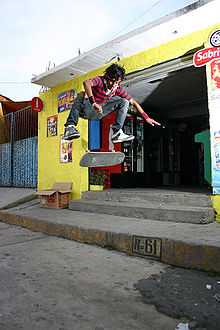Kickflip

The Kickflip is a skateboarding trick where the rider ollies and kicks his/her foot out and flips the board 360 degrees along its long axis with his/her toes, allows the board to spin all of the way around, and then catches it and lands.
It was the first of many modern flip tricks to be invented by Rodney Mullen in the early 1980s. In March of 2011, the first kickflip in surfing was landed by Zoltan "The Magician" Torkos.
Origin
In the 1970s freestyle skateboarders learned to flip the board over beneath them by lifting an edge of the board with the top of one toe. While the board flipped completely over, It did not gain much clearance from the ground, and the setup required the rider to stand more parallel to the direction of motion, with both feet facing the nose. Very well known and commonly performed today, the kickflip is a basic skateboarding trick. However it is hard to learn and beginners often take quite a long time to acquire it. Once they have mastered the trick on flat ground, many skateboarders like to up the stakes and start taking this recently-learned maneuver down obstacles. They also start combining it with other tricks such as kickflip to frontside boardslide.
In 1983[citation needed] Rodney Mullen invented the modern form of the trick,[1] initially naming it the "magic flip"[citation needed]. He first would use his relatively new flatground ollie to leave the ground, then, instead of lifting an edge with a toe, he initiated the flip by sliding his front foot off the top of the board.
Mullen's kickflip technique gave him more control in several areas: the height of the clearance, the initiation time and speed of the flip, and the board's direction during the flip. This technique was quickly adopted by freestyle skaters and later by street skaters, introducing skateboarding to the era of flip tricks, many of which Rodney Mullen also created.
Execution

To perform a kickflip, the rider ollies into the air, and lifts the back foot from the board while simultaneously sliding the front foot off the skateboard diagonally forward and towards the heel of the foot. This front foot motion, sometimes called "the flick" [citation needed], spins the board, flipping it completely over. Before landing, the rider stops the spin by returning the feet to the board as it nears its original position.
The board revolves around its longitudinal axis, like an aileron roll. To understand this motion and the direction of rotation, imagine stepping backwards off of a skateboard, leaving it in front of you, then rolling it over on the ground toward you; during the kickflip, the board spins similarly, but in mid-air beneath the rider. During a heelflip, a similar trick, the board rotates in the opposite direction.
Variations
Once a skateboarder masters the kickflip, many variations are possible:
- Using a faster "flick" motion, the rider can spin the board multiple revolutions before landing. These tricks are named with respect to the number of revolutions: Double Kickflip (or "Double Flip"), Triple Flip, etc.

- Many tricks combine the kickflip with a revolution of the board on the z axis in multiples of 180 degrees, as happens during a pop shove-it. Backside rotations form the Varial Flip (180 degrees), 360 Flip, 540 Flip, etc. Frontside rotations form the Hardflip (180 degrees) and 360 Hardflip.
- During a kickflip the board and rider may both rotate together frontside or backside. These tricks are generally named using the number of degrees rotated and the direction of the spin—e.g. Backside 180 Kickflip (or "Backside Flip")--but may have special names for 360 rotations.
- The rider may rotate backside or frontside in the air while the board does not. The most common variation is the Kickflip Sex-change (or "Body Varial"), where the rider spin frontside 180 degrees, landing on the board in switch stance.
- The rider and board may rotate in opposite directions. These rarer tricks have less-established names. Some skater's have coined "Mother Flip" to describe a 360 Flip (rotating backside) combined with a 360 frontside body varial.
- During the board's spin, the rider may catch it with his/her hand(s) before landing. These tricks are often named according to the type of grab used. E.g. Kickflip Indy, Kickflip Melon.
- The rider may initiate the board's flip later in the ollie (after the ascent), or with the foot used to pop the board off the ground (the back foot in an ollie or front foot in a nollie). E.g., the most common is a Nollie Lateflip (or "Frontfoot Lateflip"), where the rider initiates the "flick" of a kickflip in the middle of a nollie. The Backfoot Lateflip (or "Late Backfoot Flip") has the rider using the back foot to initiate the flip during an ollie. Generally in "late" flips, since the flip occurs when the board is more parallel to the ground, the rider must initiate it with a downward tap of the foot rather than sliding a foot off an edge.
- The Double Kickflip is often combined with other types of kickflips. Examples include the Varial Double Flip (180 degree backside rotation), Double Hardflip (180 degree frontside rotation), and the Double 360 Flip (360 degree backside rotation).
- During the flip of the board, the rider may use the top of the front foot to alter the trick. In a Kickflip Underflip, the rider reverses the direction of the spin after the board has flipped once. In a Hospital Flip, the rider stops the rotation half-way, then flips the board 180 degrees on the axis pointing in the direction of the rider's feet so it lands right side up in the opposite direction.
References
- ↑ "Charles Kazhila - From the Ground Up". ON Video Magazine (Winter, 2002). 2002.
| ||||||||||||||